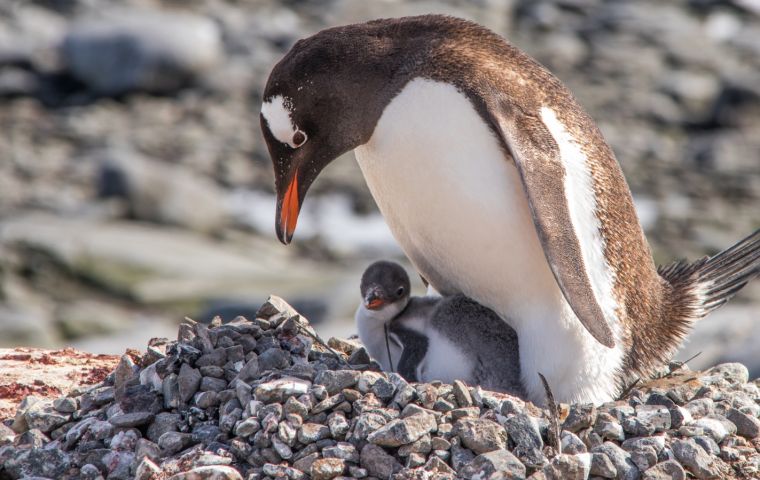MercoPress. South Atlantic News Agency
Climate change concern: Gentoo colonies moving further south
 Gentoo penguins usually live in sub-Antarctic areas.
Gentoo penguins usually live in sub-Antarctic areas. By Laura Geggel – Scientists have discovered a previously unknown colony of gentoo penguins in one of the southernmost spots these waddling birds have ever been spotted. The discovery is a cause for concern, according to the researchers, who say that climate change is expanding the range of this temperate, non-ice-loving species of penguin.
And this isn't the only concerning find. In addition to this gentoo (Pygoscelis papua) colony with 75 nests on Andersson Island, gentoo penguins have also been sighted on an unexplored archipelago off the Antarctic Peninsula's northern tip.
Both are among the first records of the species breeding so far south on the eastern side of the Antarctic Peninsula, according to a statement from Greenpeace Canada.
Previously, these areas were too icy for gentoo penguins, which prefer temperate climes where they can raise their chicks. These penguins, the third-largest living penguin species, are native to warmer sub-Antarctic islands, such as the Falkland Islands; and they usually live in ice-free areas, such as flat, rocky beaches and low-lying cliffs where large colonies can gather, according to Oceana, a nonprofit that wasn't involved with the new sightings.
During the expedition, Greenpeace invited independent scientists aboard its icebreaker vessel MV Arctic Sunrise to sail through the Weddell Sea and help count penguins on the southern continent.
“Mapping out these remote archipelagos will give us a better understanding of how the region's penguins are responding to rapid climate change,” expedition co-leader Heather J. Lynch, a professor of ecology and evolution at Stony Brook University in New York, said in the statement.
“As expected, we're finding gentoo penguins nearly everywhere we look — more evidence that climate change is drastically changing the mix of species here on the Antarctic Peninsula.”
Until now, just one solitary gentoo penguin nest had been spotted this far south. Gentoo penguins don't migrate, so conditions have to be ideal for them to stay in one location year-round.
“They're very opportunistic, so any chance they get, they're going to colonize rock as the glaciers retreat,” Lynch told Mongabay. “So they're the thing that we tend to use to see how far climate change has gone in terms of turning the Antarctic Peninsula into a more sub-Antarctic or more temperate climate.”
Many penguin populations are in flux due to the rapidly changing climate and increased industrial fishing, according to a Greenpeace statement. For instance, ice loss in Antarctica increased six-fold over the last 30 years, Live Science reported. One of Antarctica's largest glaciers — Thwaites Glacier, also known as the “Doomsday Glacier” — could collapse in just a few years, possibly increasing sea levels worldwide by more than 2 feet (65 centimeters), Live Science reported in December.
To help native animals struggling in a warming Antarctic, scientists and conservationists are pushing for three new marine protected areas around the southern continent, including in East Antarctica, the Antarctic Peninsula and the Weddell Sea, which would span 1.5 million square miles (4 million square kilometers), Mongabay reported.
“Governments need to agree [to] a new Global Ocean Treaty to deliver protection for at least 30% of the world's oceans by 2030 — and they must get to work by protecting the Antarctic's waters,” Louisa Casson, of Greenpeace's Protect the Oceans campaign, who was also aboard the Arctic Sunrise, said in the statement.
(*) Laura Geggel is an editor at Live Science. She edits Life's Little Mysteries and reports on general science, including archaeology and animals. Her work has appeared in The New York Times, Scholastic, Popular Science and Spectrum, a site on autism research. She has won multiple awards from the Society of Professional Journalists and the Washington Newspaper Publishers Association for her reporting at a weekly newspaper near Seattle. Laura holds a bachelor's degree in English literature and psychology from Washington University in St. Louis and an advanced certificate in science writing from NYU.




Top Comments
Disclaimer & comment rules-

Read all commentsEstimado Tænk — P U G O L - TTWH
Jan 25th, 2022 - 01:14 pm 0_______________________
This is a continuation from last night’s debate…
_______________________
Sorry for the interruption…
…If we are comparing automobiles — I agree with the Volvo P1800 — however I submit the Skoda OCTAVIA ESTATE
https://www.skoda-storyboard.com/en/skoda-world/unknown-history-octavia-cars-were-made-in-chile-50-years-ago/
My lovely dinner companion required my complete attention last night — but if she was an automobile — she definitely would be a Citroën Maserati…
(…if you remember — my first auto was a Lada and Madame possessed a Citroën Citroneta 2CV…)
The dinner was highly pleasant with good conversation — with everyone previously associated with our Naval Academy.
Today’s morning fare is avocado and smoked salmon on sourdough with perfectly prepared café lattes — while reading the news.
Weather here is perfect!
¡Saludos cordiales desde Viña del Mar!
Commenting for this story is now closed.
If you have a Facebook account, become a fan and comment on our Facebook Page!